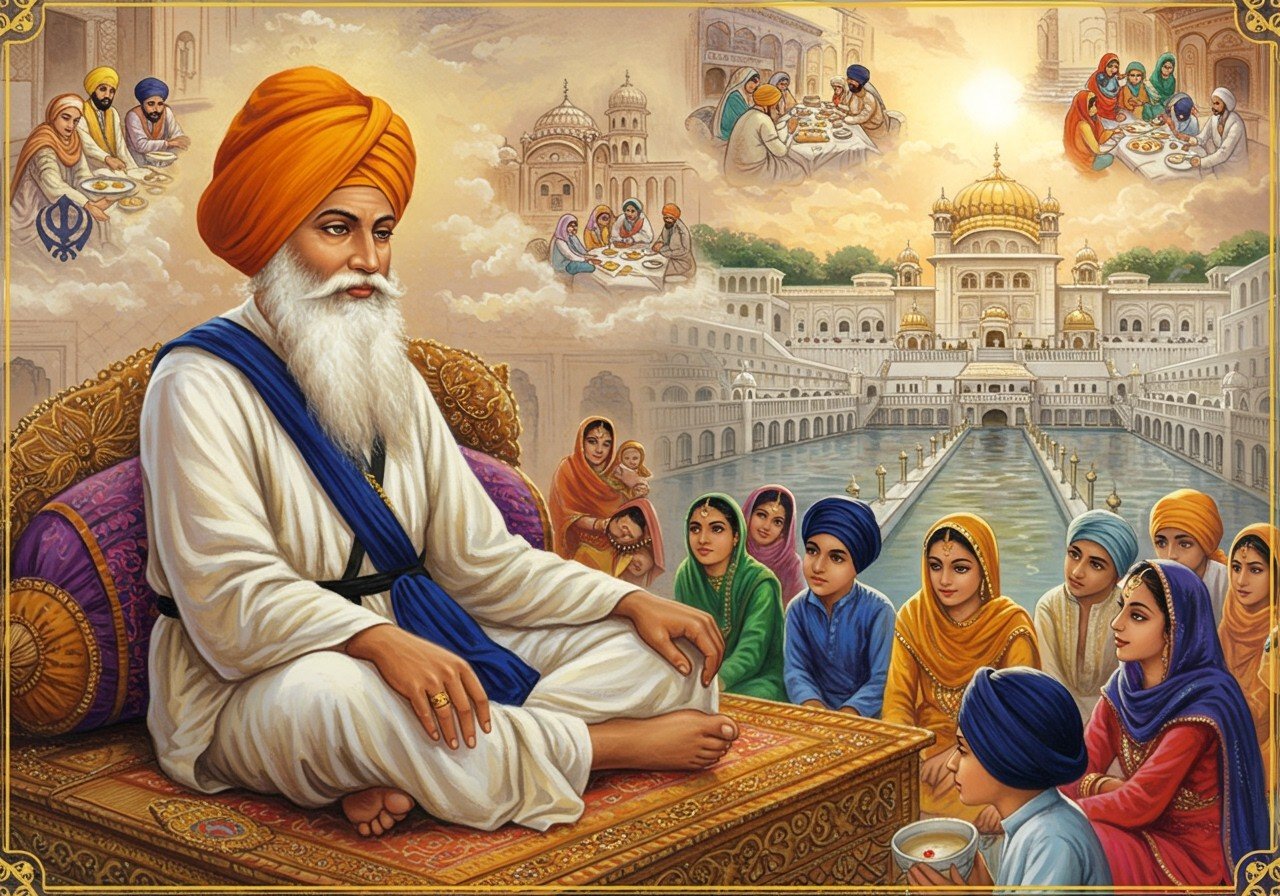
Guru Amar Das Ji, the third Sikh Guru, holds a special place in the hearts of Sikhs worldwide. Born on May 5, 1479, in Basarke, Punjab, his life is a testament to the power of devotion, humility, and service. His parents, Tej Bhan and Mata Lachmi, raised him with strong spiritual values, initially within the Hindu faith. A profound shift occurred at the age of 60 when he encountered a hymn by Guru Nanak Dev Ji. This experience deeply moved him, leading him to embrace Sikhism and dedicate himself to serving Guru Angad Dev Ji, the second Sikh Guru. In 1552, at the age of 73, he was appointed the third Guru, a role he filled with utmost dedication.
Early Life and Transformation
Guru Amar Das Ji’s life story resonates with many. Married to Mansa Devi, he was a family man with two sons, Mohan and Mohri, and two daughters, Dani and Bhani. Despite his family responsibilities, his spiritual yearning remained strong. His encounter with Guru Angad Dev Ji transformed his life, leading him on a path of selfless service and unwavering devotion to Sikhism. This dedication laid the foundation for his future role as a Guru.
Explore Holy Books at Poojn.in
Key Teachings and Contributions
Equality, selfless service (seva), and humility formed the core of Guru Amar Das Ji’s teachings. He passionately believed in the equality of all, regardless of caste, creed, or gender. This belief manifested in the Langar, the community kitchen he championed, where everyone, rich or poor, could share a meal together. It’s said that even Emperor Akbar partook in the Langar before meeting Guru Amar Das Ji, a powerful symbol of unity and equality. Guru Amar Das Ji formalized the Anand Karaj, the Sikh marriage ceremony, solidifying its sacredness and importance within the Sikh faith.
Beyond these vital contributions, Guru Amar Das Ji also established the Manji system, a network of religious centers, to spread Sikh principles far and wide. His prolific writings, including numerous hymns, enriched Sikh scripture and significantly contributed to what would later become the Guru Granth Sahib, the holy book of Sikhism. He also championed the use of the Gurmukhi script, further strengthening Sikh identity.
Find the Srimad Bhagavad Gita at Poojn.in
Stories and Anecdotes
Stories from Guru Amar Das Ji’s life offer beautiful insights into his character. One recounts his initial hesitation to accept the Guruship, reflecting his deep humility. Another tells of his selfless service, offering water to thirsty travelers, embodying the Sikh spirit of seva. Many stories highlight his commitment to women’s equality, challenging social norms of the time and empowering women within the Sikh community. These narratives, passed down through generations, bring his teachings to life and inspire us to this day.
Ten Fascinating Glimpses into the Life of Guru Amar Das Ji
- Goindwal Sahib: He founded the city of Goindwal Sahib, establishing it as a vital spiritual center for Sikhs. This act further solidified the growing Sikh community and provided a dedicated space for worship and learning.
- Champion of Women’s Rights: He fiercely opposed the practice of Sati, advocating for the rights and dignity of widows. He actively encouraged widow remarriage, challenging societal norms and championing women’s empowerment.
- The Manji System: Guru Amar Das Ji created the Manji system, a network of religious centers, which played a crucial role in disseminating Sikh teachings across different regions. This innovative approach allowed for a more organized and efficient spread of Sikhism.
- Hymns of Devotion: His devotional hymns, filled with spiritual wisdom, became an integral part of the Guru Granth Sahib. These hymns continue to inspire and uplift Sikhs worldwide with their profound messages.
- Langar: The Community Kitchen: He strengthened the tradition of Langar, emphasizing the values of community and equality. This practice became a cornerstone of Sikhism, fostering a sense of belonging and shared humanity.
- The Golden Temple: Guru Amar Das Ji chose the site for the Harmandir Sahib, which would later become the Golden Temple, the most sacred shrine in Sikhism. This act of foresight laid the foundation for one of the world’s most iconic religious landmarks.
- Social Justice Advocate: A strong advocate for social justice, he promoted equality among all people, regardless of background or status. His commitment to equality transcended societal divisions and promoted a sense of unity.
- Preservation of Gurmukhi Script: He actively encouraged the use of the Gurmukhi script, preserving and promoting the Sikh language and literary tradition. This contributed significantly to the development of Sikh literature and cultural identity.
- Unity and Harmony: He emphasized unity and harmony among his followers, fostering a strong sense of community and shared purpose. This emphasis on unity became a defining characteristic of the Sikh community.
- Pioneer of Community Service: Through the Langar, he pioneered community service, instilling the value of seva (selfless service) in his followers. This concept of selfless service became a fundamental tenet of Sikhism.
Legacy and Impact
Guru Amar Das Ji’s legacy extends far beyond the Sikh community, impacting Indian society as a whole. His teachings on equality and selfless service continue to resonate with people from all walks of life. His social reforms, particularly his efforts towards gender equality, were revolutionary for his time and continue to inspire today. Goindwal Sahib, the city he founded, remains a significant pilgrimage site, drawing devotees seeking spiritual solace and connection to his teachings. His life serves as an enduring example of humility, devotion, and unwavering commitment to serving humanity.
Honoring Guru Amar Das Ji with Poojn.in
At Poojn.in, we offer a curated collection of authentic religious items to connect with the teachings of Guru Amar Das Ji. Consider these items to enhance your spiritual practice:
- Guru Granth Sahib covers and stands: Show reverence for the holy scriptures.
- Brass Khanda symbols: Represent Sikh identity and values.
- Prayer beads (mala): Enhance your meditation practice.
- Kesri (saffron) cloth pieces: Traditionally used for covering heads during prayer.
- Wooden Chaur Sahib: A symbolic representation of seva (selfless service).
- Picture frames of Guru Amar Das Ji: A visual reminder of his inspiring life.
Visit www.poojn.in or call us at 03369029784 to explore our collection. For quicker assistance, WhatsApp us at 9476142738. We offer pan-India delivery with secure packaging. All products are quality-checked and ethically sourced from trusted manufacturers.
Conclusion
Guru Amar Das Ji’s life and teachings offer timeless wisdom for all. He exemplified humility, equality, and service, leaving an indelible mark on Sikhism and the wider world. By embracing unity and compassion, he inspired social reforms that continue to resonate today. His unwavering commitment to women’s rights and social justice reminds us of the importance of standing up for what is right. His life story is a beacon of hope, inspiring generations to come to live a life dedicated to selfless service and promoting equality.


